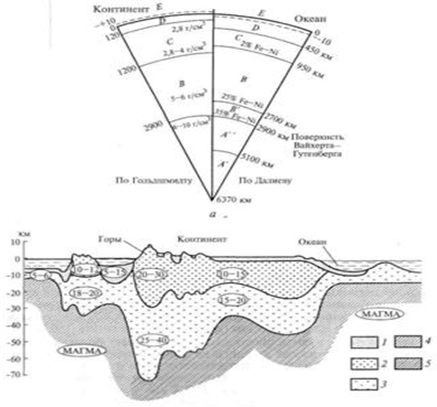
1.1 Engineering geology as a science
Engineering geology is one of the sciences of the geological cycle, which studies the geological environment, its rational use and protection in connection with the engineering and economic activities of man.
The geological environment should be understood as any rocks and soils that make up the upper part of the lithosphere (earth's crust), which are considered as multicomponent systems that are influenced by human engineering and economic activity, which leads to a change in natural geological processes and the emergence of new anthropogenic (engineering and geological) processes. altering the geotechnical conditions of a certain territory (E. M. Sergeev).
Geotechnical conditions characterize the features of the geological structure of the study area, the composition and properties of the rocks composing it, geological processes, relief and groundwater.
The geotechnical conditions of the construction site are affected by:
- to choose the location of objects;
- on the construction of structures and the depth of the foundation
comrade;
- on the methods of construction works and environmental protection measures.
Engineering structures, in turn, can change the existing natural geological conditions:
- cause sediment (compaction) or shifts in the rocks on which they are built;
- change the relief layout and bedding;
- change the microclimate and depth of soil freezing, groundwater level;
- accelerate the development of ravines, landslides and other dangerous geological processes.
Engineering and geological assessment of construction conditions is determined depending on both natural factors and the type and structures of the structure, on the nature of its impact on the rocks during construction and operation.
The main sections of engineering geology:
- soil science;
- engineering geodynamics;
- regional engineering geology.
Soil science - studies the rocks that make up the lithosphere as soils. Grounds are rocks that are in the field of human engineering and business activities. Rocks (soils) consist of minerals or mineral aggregates that have a certain chemical composition and physical and mechanical properties that affect the construction characteristics of the soil. Soil science studies the mineralogical composition of soils, their genesis (origin), structure and texture, i.e., those characteristics that affect the strength and stability of soils under load from buildings and structures.
Simultaneously with soil science, soil mechanics was being formed at the junction of geological, physical, mathematical and construction disciplines. Soil mechanics examines the general laws that arise from the application to rocks (soils) of the laws of theoretical and structural mechanics in connection with loads.
Soil science characterizes the soils of the base of the structures in an undisturbed state prior to construction and predicts their change during the construction and operation of the structures.
Engineering geodynamics - studies natural and engineering-geological hazardous processes and phenomena affecting the construction and operation of facilities. These are gravitational processes on the slopes and in the pits, ravine formation, geological activity of rivers, wind, sea, etc.
Engineering-geological processes and phenomena are called when their origin or development is associated with engineering and economic activities of man. Typically, such processes and phenomena occupy smaller areas, do not have large development speeds.
Regional engineering geology studies the patterns of formation and distribution of geological conditions on the territory. Geotechnical conditions are the same or similar for those territories that have the same or similar history of geological development and are located in the same natural and climatic zones. Its task is to draw up engineering-geological maps, identify regions, regions, districts and subdistricts (according to the classification of I. V. Popov) with similar engineering-geological conditions.
Creation of engineering geological maps significantly reduces the time and amount of survey work at construction sites, which gives a certain economic effect.
For civil engineers, the main document in the design of buildings and structures is an engineering-geological map and a conclusion with an assessment of the engineering-geological conditions of the construction site.
1.2 Planet Earth
The Earth is the third planet of the Solar System, has the shape of a geoid (approximated with an ellipsoid of rotation) and a centrally symmetric structure with several shells or geospheres.
The air envelope - the atmosphere - with a total height of about 1,300 kilometers, has, in turn, a layered structure with diffuse, penetrating each other boundaries. Its first floor is the troposphere, above is the stratosphere, the ionosphere and the dispersion zone.
The water shell — the hydrosphere — includes seas, oceans, lakes, rivers, water in the atmosphere and lithosphere in liquid, solid and gaseous states. The distribution is uneven. North of the equator, almost the same land area and water, and in the southern hemisphere, the oceans occupy 90% of the surface.
The lithosphere - the stone shell of the Earth or the crust of the earth is composed of rocks. It has a different structure under the oceans and continents (Figure 2), the mantle is located under the earth's crust, and from the depth of 2900 km is the core.
Biosphere - the sphere of life in all geospheres of the Earth. When polluted by anthropogenic emissions goes into a state unfit for life - the neosphere.
There are natural and man-made connections between the geospheres. There is a continuous exchange of matter and energy, the geological processes of the internal and external dynamics of the Earth are born. Human engineering activity can speed up or slow down the development of dangerous geological processes, which leads to disruption of the natural balance of the geological environment.
The geological environment is the upper part of the earth’s crust - the lithosphere, where engineering and economic activities of a person flow: mines, quarries, foundations, wells for water, oil, gas, etc., determine its thickness.
Among the numerous hypotheses of the origin of the Solar System and the planet Earth, the most developed at the present time are the meteorite hypothesis of O. Yu. Schmidt and the cosmogenic hypothesis of V. G. Fesenkova.
Academician O. Yu. Schmidt in 1944 proposed a hypothesis of the origin of the solar system, according to which the formation of planets and their satellites originated from primary meteoric matter captured by the attraction of the sun, under the influence of the gravitational field of which the meteoritic material was redistributed with the formation of the solar system.
According to the hypothesis of V. G. Fesenkov (1960), the Sun and the planets were formed as a result of the condensation of one of the giant nebulae in space. Then, at first, the Sun was formed, and then in the process of its evolution, the planets of the Solar System arose.
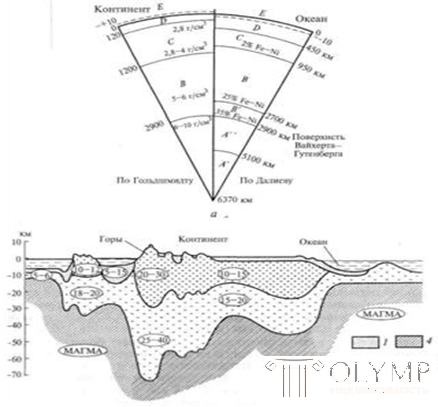
00
Figure 2 - Schematic representation of the structure of the Earth (a) and the earth's crust (b):
A is the core; B, C - mantle; D - earth crust; E - atmosphere (according to M. Vasich); 1 - overburden; 2 - granite-like layer; 3 - basalt layer; 4 — upper mantle; 5 - mantle.
The study of space, flights to other planets, to the Moon provide many new factors for the practical testing of hypotheses and their further development and improvement, since none of them currently provides a complete answer to the questions of the origin of the solar system and the planet Earth.
1.3 Geological time and age of rocks
The crust was formed for a long time, gradually, unequally in different periods of time; various physicogeographic conditions. In some areas there was an accumulation of precipitation, then their collapse into folds or discontinuous (dislocation) blocks during mountain-building processes; then there were periods of destruction of the mountains, the transfer of material and its accumulation in new places on land or in the oceans, which sometimes occupied large areas, then retreated from the coastline, leaving on the land thick layers of marine sediments — limestone, marl, conglomerates, etc.
To recreate the history of a certain territory, to compile geological maps and sections, it is necessary to know the age of the rocks composing a particular section of the earth's crust.
There are two types of rock age:
- absolute, expressed in years (million years). For this purpose, a process of radioactive transformations is used in the direction of the formation of some chemical elements from others. The most commonly used methods are: lead, strontium, argon and carbon.
- relative - age is considered for one rock relative to another, younger or older than it in time of formation. Use the following methods:
a) stratigraphic - describes the sequence of occurrence
rocks in order of their formation. Applicable in case of undisturbed occurrence of rocks, when each overlying rock is younger than the underlying formation.
b) paleontological - applicable in the presence of fossils in the sediments of fossils - the remnants of living organisms buried in layers. Organic life on Earth has evolved from simpler to more complex forms. Therefore, the more ancient layers will contain fossils of simpler organisms. Studied science historical geology.
Based on the generally accepted international units of stratigraphy and relative geochronology, a consolidated scale of geological time is created — a geochronological table, where each time interval corresponds to its own complex of rocks formed at that time (Table 1).
Table 1 - The ratio of taxonomic units
Segmentation of rocks | Group | system | Department | tier |
Corresponding length of time | era | period | an era | century |
Each taxonomic unit of the scale is assigned its own alphabetic and numeric indices and a strictly defined color for any geological map of the world (Appendix A, B).
1.4 Minerals and Rocks
Rocks that form the crust are aggregates composed of various minerals.
Minerals are compounds that are relatively homogeneous in chemical composition and formed as a result of complex physicochemical processes in the interior of the Earth or on its surface. Minerals can be solid (quartz, hornblende), liquid (native mercury) and gaseous (hydrogen sulfide, methane). The overwhelming majority of solid minerals are crystalline formations and only a small part of them are amorphous. Minerals that are in a crystalline state are most often found in nature in the form of aggregates (clusters of grains) of irregular shape and much less often in the form of regular polyhedra — crystals. The sizes of mineral individuals can be from large ones, the mass of which is several tons (feldspar, quartz) to the smallest grains visible only in a microscope. Most of the minerals are found precisely in the form of small and tiny grains, forming a granular structure of igneous, sedimentary and metamorphic rocks.
In nature, there are about 7,000 minerals and their varieties. Each of them has a certain structure and has its own complex of physical properties (hardness, specific gravity, cleavage, magnetism, etc.), affecting the engineering-geological (construction) properties of the rocks of the geological environment.
The most common is the chemical classification of minerals:
Silicates are the most numerous class, comprising up to 800 minerals, which are the main component of most igneous and metamorphic rocks. Among the silicates, there are groups of minerals characterized by a certain generality of composition and structure — feldspars, pyroxenes, amphiboles, mica, and also olivine, talc, chlorites, and clay minerals. All of them are aluminosilicates in composition.
Oxides and hydroxides. These two classes combine about 200 minerals, they account for up to 17% of the total mass of the earth's crust. The most common are quartz, opal and limonite.
Carbonates. These include more than 80 minerals. The most common calcite, magnesite, dolomite. The origin is mainly exogenous and is associated with aqueous solutions. In contact with water, they slightly reduce their mechanical strength, although slightly, but dissolve in water and break down in acids.
Sulfates. This class combines up to 260 minerals, the origin of which is associated with aqueous solutions. Characterized by a small hardness, light color. Relatively well soluble in water. The most common are gypsum and anhydrite. In contact with water anhydrite goes into gypsum, increasing in volume up to 33%.
Sulfides account for up to 200 minerals. Typical representative of pyrite. Sulfides in the weathering zone are destroyed, so their admixture reduces the quality of building materials.
Halides contain about 100 minerals. The origin is mainly due to aqueous solutions. Halite has the greatest prevalence. It may be an integral part of sedimentary rocks, easily soluble in water.
Minerals of phosphate classes , tungstates and native elements are much less common than others.
There are other classifications of minerals.
Rocks of the earth's crust can be monomineralic, t.
e. consist of a single mineral (marble, dunite) or polymineral, consisting of several rock-forming minerals (granite, gabbro). The rock is formed in a kind of geological conditions, which determine its mineralogical composition, the shape of the structure and texture of the occurrence.
By their origin, all rocks are divided into three large groups, which simultaneously reflect their genesis and the most important petrographic features.
- igneous, associated with the processes of magmatic activity;
- sedimentary, associated with exogenous processes, i.e. processes of external dynamics of the Earth;
- metamorphic, resulting from the transformation of igneous and sedimentary rocks.
1.4.1 Igneous rocks.
Igneous rocks are formed as a result of cooling and crystallization of magma (Table 2). Magma is a fiery liquid melt-solution containing various elements, their oxides and volatile components (fluorine, chlorine, water, carbonic acid, etc.). In the process of crystallization of magma, the components redistribute. If the formed crystals are removed from the magma chamber, for example, they descend into deeper horizons or float to the upper horizons, the composition of the magma will gradually change and various rocks will crystallize from it. An important role in the formation of rocks of different composition is played by the processes of assimilation of the capture and melting of rocks by magma on contact with the source. At the final stage of crystallization of magma, residual overheated igneous melts and solutions enriched in volatile components penetrate into the surrounding rocks along the cracks and give rise to pegmatite, hydrothermal and pneumometry mineralization processes. When magma solidifies at great depth with a slow drop in temperature and pressure, complete crystallization of intrusive (deep) igneous rocks occurs. Granite, gabbro, diorite, etc. have a full-crystalline (granular) structure and a massive texture. A block is a diagram of the forms of occurrence of magmatic bodies (according to M. Vasich) (Figure 3).
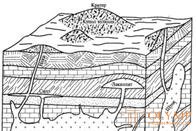
Figure 3 - Block - diagram of the occurrence of igneous bodies (according to M. Vasich)
When magma breaks through cracks to the surface of the Earth, the magma loses some of the volatile compounds, goes into a lava state and with a rapid change of pressure and temperature freezes on or near the surface, forming effusive (oozed) rocks: basalts, diabases, porphyrites, etc. -crystalline, glassy or porphyritic structure and massive or slag texture. Forms of occurrence: streams, covers, cones, etc. (Figure 4.)
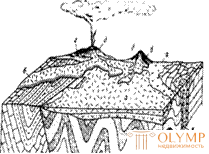
Figure 4 - Forms of effusions.
Covers (a), flows (b), nekki (c), somma (d), cones (d), on the surface and in cuts.
Fracture of igneous rocks
When the magma is cooled, its volume decreases, which causes the formation of cracks in the rock.
These cracks mass of the rock is divided into separate, t.
E. To pieces or blocks of various shapes. Depending on the system of the location of the cracks, there are plate-like, parallelepipedal, blocky, polyhedral, columnar and spherical separations.
The slab-like separateness is formed when there are frequent horizontal and very rare vertical cracks, which makes it possible to produce slabs of large sizes during the development.
In the case when the rock is broken by frequent horizontal and vertical cracks, the separations are parallelepiped-shaped.
With an incorrect system of cracks, blocky or mattress-like separations are obtained. Система трещин, пересекающих породу в нескольких определенных направлениях, приводит к образованию многогранной отдельности.
Трещины могут также разделять породу на многогранные столбы - столбчатые отдельности - или шарообразные глыбы - шарообразные отдельности.
Трещиноватость может быть:
а) Первичная трещиноватость отдельности образуется в процессе
остывания и кристаллизации магмы. Наиболее часто встречаются трещиноватости – матрацевидная, столбчатая (базальты), шаровидная (диабазы). Трещины отдельности проявляются при выходе породы на поверхность, при выветривании или взрыве.
б) Вторичная трещиноватость проявляется в виде тектонических трещин в процессе горообразования и выражает направление стресса. Кроме того, к вторичным относят первичные и тектонические трещины, расширенные процессами выветривания.
В зависимости от системы расположения трещин их различают (рисунок 5).
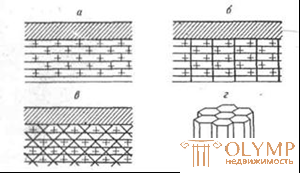
Рисунок 5 - Система трещин и отдельностей изверженных горных пород
а – плитообразная; б – параллелепипедная; в – глыбовая или матрацевидная; г - столбчатая или шарообразная.
Трещиноватость пород повышает скорости выветривания пород, способствует более глубокому их проникновению, снижает декоративные и прочностные характеристики магматических пород и требует исследований свойств не только в отдельных образцах, но и в массиве.
Таблица 2 - Классификации магматических пород
Группы пород | Минералогический состав | Интрузивные породы | Эффузивные породы | |
Кайнотипные (молодые) | Палеотипные (древние) | |||
Ультракислые и кислые SiO2 > 65% | Палевые шпаты (ортоклаз), кварц | Пегматит | Липарит | Кварцевый порфир |
Полевые пшаты, кварц, слюда | Granite | |||
Average SiO2 = 52 - 65% | Полевые шпаты (ортоклаз, плагиоклазы), кварц, слюды, роговая обманка, биотит | Сиенит | Трахит | Ортоклазовый Порфир |
Полевые шпаты (плагиоклаз), роговая обманка, авгит, биотит | Диорит | Андезит | Порфирит | |
Main SiО2 = 45 - 52% | Полевые шпаты, авгит, биотит | Габбро | Basalt | Диабаз |
Labrador | Лабрадорит | |||
Ультраосновные SiО2, < 45% | Авгит | Пироксенит | ||
Оливин, авгит | Перидотит | |||
Оливин | Дунит | |||
Вулканогенные | Стекло, преимущественно кислого состава | Обсидиан | ||
1.4.2 Осадочные породы
В образовании осадочных пород (литогенезе) (таблица 3) можно выделить следующие стадии:
- образование исходного материала при разрушении магматических, метаморфических или ранее образовавшихся осадочных пород в ходе процессов выветривания, абразии, эрозии, корразии, суффозии и др., а также при извержении вулканов.
- перенос материала в воде или на суше (транспортирование) в виде растворов, обломков или пыли.
- накапливание (седименттогенез) в водоемах или на поверхности Земли осадка в виде эоловых форм рельефа, морских, озерных или речных террас, ледниковых морен и др.
- преобразование осадков в осадочную горную породу (диагенез) при уплотнении, выпадении из растворов и кристаллизации, окисления, гидратации, восстановления в рыхлых осадках.
- изменение осадочной породы (катагенез) до начала метаморфизации или начала выветривания.
При генетической классификации осадочных пород (таблица 3) выделяют группы:
- обломочные - осадки механического происхождения, которые по размеру обломков разделяют на глубокообломочные, песчаные, пылеватые и глинистые, рыхлые и сцементированные;
- chemical precipitates are formed at the bottom of reservoirs as a result of precipitation of substances from true aqueous solutions, and also are deposits of groundwater;
- organogenic sediments are formed due to the accumulation of waste products of marine organisms, less often freshwater invertebrates;
- mixed sediments - have a complex composition and contain in different ratios of detrital, organogenic and chemical material.
-
Table 3 - Classification of sedimentary rocks
Group of rocks | Breed name | Major Minerals | Predominant structures | Prevailing textures |
Mechanical precipitation | Clay, argillite | Clay minerals | Celite | Disorderly, layered |
Less, aleurite, siltstone | Polymineral | Aleuritovaya | Disorderly, layered |
walking | Sand, sandstone | Polymineral | Psammitic | Erratic, layered |
Pebbles, gravel, boulders, ben, dresva, cobs, conglomerate, breccia | Polymineral | Psefit | Erratic | |
Chemical precipitation | Limestone | Calcite | Oolitic, pelitic | Massive |
Lime Tuff | Calcite | Crystalline | Porous | |
Rock salt | Galit, Silvin | Full crystal | Massive | |
Gypsum | Gypsum | Full crystal | Massive | |
Anhydrite | Anhydrite | small and medium crystalline | Massive layered | |
Dolomite | Dolomite | Pelite, Fine grain | Massive, less layered | |
Organo-gene precipitation | Thick limestone | Calcite | Full crystal, Crystalline | Massive, banded |
Limestone | Calcite | Biomorphic | Porous | |
a piece of chalk | Calcite, impurities of gly- white minerals | Celite | Porous | |
Siliceous (flask, tripoli, diatomite) | Quartz (opal) | Celite, cryptocrystalline | Porous | |
Mixed | Marl | Calcite, clay minerals | Celite | Fused |
Bauxite | Aluminosilicate minerals | Psefit, oolitic | Erratic |
Forms of sedimentary rocks
Sedimentary rocks occur in the form of layers, which are formed in the process of periodic accumulation of precipitation in the water and air environment. The composition of the layer may be microlayer, reflecting sedimentation at different times of the year. Microlayer is characteristic of lake and river sediments. In the layer of rock can also be thin layers of other rocks. They are called interlayers. For example, in a layer of sand there may be a thin interlayer of clay.
With a sharp difference in layers in composition, for example, a layer of sand lies on a layer of limestone; more or less constant power and a relatively large occupied area, the layers are called layers. In such cases, layers (layers) are usually bounded on both sides by distinct surfaces, which are called bedding planes (surfaces) , the upper plane is called the roof, the lower the bed or the bottom, and the distance between them is the layer (layer) thickness. The marine sediments have the greatest thickness of the seams (up to hundreds and even thousands of meters). Continental formations of the Quaternary system, located directly under the soil layer, have, as a rule, a relatively small thickness (10–50 m).
A complex of layers, united by a similarity of composition or age, or one layer, but of considerable thickness, is often called the thickness. An example is the stratum of loess rocks, whose thickness can reach tens of meters.
Layers are formed in the process of accumulation of precipitation in the seas, lakes, river valleys, etc. This causes the formation of layers of various shapes, both in size in plan and in outline along the vertical. The most common is the normal layer , which is characterized by relatively high power and length, parallel to the roof of the sole. For continental sediments are also characteristic lenses - layers that occupy small areas with pinching out power to the edges of the layer, and wedging layers, the thickness of which decreases in one direction.
An important practical value for engineering geology is a combination of layers. When agreed to lay the layers are parallel to each other, often horizontally. Such bedding is characteristic of the plains. In other cases, due to the tectonic movements of the earth's crust, inconsistent bedding occurs. One group of layers in this case lies non-parallel to the other group of layers (Figure 6).
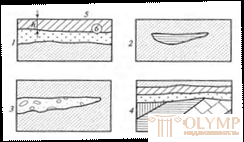
Figure 6 - Forms of layers of sedimentary rocks:
1 - normal occurrence; 2 - clay lens in the sand;
3 - pinching out of the tick in the sandy column; 4 - inconsistency of the soil; 5 - the surface of the earth (roof layer);
6 - sole (bed) layer; h - layer thickness
Layers having the same elements of occurrence form a pack according to the underlying rocks. One bundle of layers relative to another may lie unconformed along the line of disagreement. Disagreement may be angular, stratigraphic, tectonic, and others.
(Figure 7).
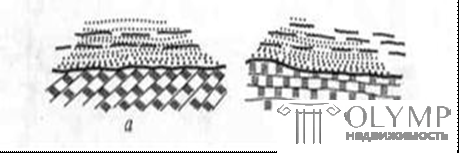
Figure 7 - Angular Disagreement (a); break in sedimentation (b)
The surface strata of the lithosphere is 75% composed of sedimentary rocks, which are often the basis and medium of the structure. In the engineering-geological assessment of sedimentary rocks, occurrence, mineralogical composition, engineering
geological (construction) properties of each layer for the entire depth of the influence of structures.
1.4.3 Metamorphic rocks
Getting into the physico-chemical conditions, different from those in which it was formed, the breed begins to adapt to new conditions by changing the mineral composition, structure and texture without changing the total chemical composition, or with its change due to the transfer or removal of the substance. Such a process is called metamorphic.
The main factors causing the metamorphization of rocks are temperature, pressure and chemical active substances, solutions and gases. Metamorphization processes proceed with preservation of the solid state of the system, without substantial melting of the rock.
Any rocks can be transformed (metamorphic) - igneous, sedimentary and previously formed metamorphic rocks.
Depending on the prevailing factors of metamorphism, there are:
- Regional metamorphism - manifested on large areas when diving large areas of the lithosphere to depths, characterized by high pressures and temperatures, gneisses, quartzites, schists, less often marble and marbled limestones are formed.
“ Contact metamorphism is the process of changing rocks on the contact of intrusive bodies with host rocks. Here the rocks are exposed to high temperatures and the chemicals that make up the magma. The most common rocks are hornfels, marble.
- Dynamo metamorphism (cataclastic) - manifests itself in various tectonic processes causing the occurrence of directional pressure. Rocks acquire shale, are subjected to mechanical crushing. Have a different degree of cementation (breccia).
The mineralogical composition (table 4), relict occurrence forms, i.e., inherited from the source rocks.
In the engineering - geological assessment of metamorphic rocks, special attention is paid to the degree of metamorphization, shale and weathering.
Table 4 - Classification of igneous rocks
Engineering survey. Geology. Geodesy.Newsletter |
Что бы оставить комментарий войдите
Комментарии (0)
To leave a comment, login or register.
Comments ( 0 )